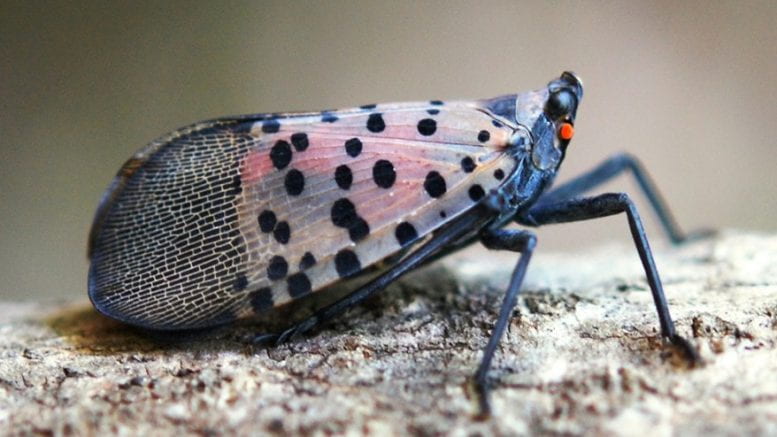If you have ever taken a long stroll around campus, chances are you have seen one of the bugs that is pictured above. If you have seen one of these, you could have just walked by it, looked at it and then walked away, or you could have squashed it. These odd brown bugs are called spotted lanternflies, and they are a massive issue. The spotted lanternfly changes a lot in its lifetime, and you may not know what is the spotted lanternfly and what isn’t. A spotted lantern fly’s life cycle starts as an egg mass on a tree. These egg masses look a lot like cement, and the best thing you can do when you see one is to scrape it off of the tree it is on. The next stage is the nymph, they can either be all black or black with red, both having white spots. The final stage of its life is the brown bug you have seen around today.
The true reason that these bugs are so dangerous is because they are an invasive species originating in Vietnam, India, and China. They were first discovered in Pennsylvania in 2014, seen in Berks County. These bugs are a huge threat to trees, as they use them to lay their eggs. The spotted lanternflies kill trees, contributing to climate change and deforestation. When you see the spotted lanternfly, kill it immediately. Even if you dislike killing bugs, like I do, you absolutely have to kill the spotted lanternfly.
Some researchers have made clever inventions that work to trap and kill spotted lanternflies. One of which is planted directly on the tree called the “Sticky Band.” Sticky bands are simple traps, but they can kill hundreds of spotted lanternflies at a time. The trap is placed on the tree, and as spotted lanternflies come to lay their eggs, feed on the tree or for any other reason, they are caught in the glue on the trap. Sticky bands are easy to install, all you have to do is wrap it tightly around the tree’s trunk at least four feet above the ground. Pull as hard as you can, leaving no room for air and then staple the band closed onto the tree. Sticky bands work best when installed in summer months when the nymphs will start to climb and infest trees. Yet unfortunately, the sticky band isn’t without its flaws. Sometimes, small mammals or birds can find themselves stuck in the glue. There are ways to decrease other creatures getting stuck to the sticky band though. You can cut the band in half, or you can put chicken wire over trap so that larger creatures cannot get stuck. Only put sticky bands on trees that you know for sure are infested with spotted lanternflies.
According to my interview with Dr. Z, the spotted lanternfly is often seen on our tennis courts and the main building’s windows. She says that even predatory bugs like the praying mantis don’t seem to be taking notice of the Lanterflies, which is very concerning because that means population control will be even more of a challenge. Spotted lanternflies prefer to infect the walnut tree, which is native to our area. She told me the flies are especially attracted to a nonnative tree called the “tree of heaven.” The tree of heaven is an invasive species itself, and its removal will help the eradication of Spotted Lanternflies.
If you ever see a spotted lanternfly outside of the blue areas below, report it to the Pennsylvania Department of agriculture immediately. Your discovery is very important. Even if you’re not able to mail them a sample (body, egg cluster, etc…) the discovery needs to be reported.
By Nell Zuckman, ‘26



